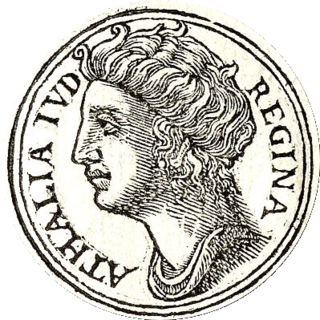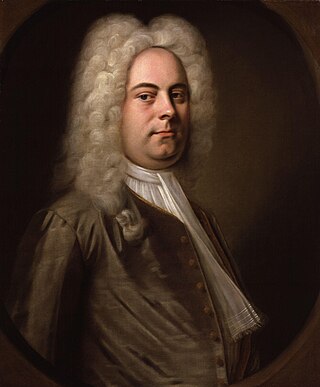See also
- Adalia (disambiguation), alternate spelling
- Atalya (disambiguation)
Attalia is the ancient name of Antalya, a city on the Mediterranean coast of southwestern Turkey.
Attalia, Atalia, or similar spellings may also refer to:
Galatea is an ancient Greek name meaning "she who is milk-white".
Judas Iscariot was the apostle of Jesus who betrayed him.

Judah Maccabee was a Jewish priest (kohen) and a son of the priest Mattathias. He led the Maccabean Revolt against the Seleucid Empire.

Athaliah was the daughter of either king Omri, or of King Ahab and Queen Jezebel of Israel, the queen consort of Judah as the wife of King Jehoram, a descendant of King David, and later queen regnant c. 841–835 BCE.
Theodora may refer to:
Adalia may refer to:
Saul, or Shaul, was the first king of the united Israel and Judah.
Atalya may refer to:
Semele is the mother of Dionysus in Greek mythology.
Athalia, provisional designation 1903 ME, is a carbonaceous Themistian asteroid from the outer regions of the asteroid belt, approximately 40 kilometers in diameter. It was discovered on 20 September 1903, by German astronomer Max Wolf at the Heidelberg Observatory in southwest Germany. The asteroid was named after the ancient Judahite queen Athaliah.

Athalia is an English-language oratorio composed by George Frideric Handel to a libretto by Samuel Humphreys based on the play Athalie by Jean Racine. The work was commissioned in 1733 for the Publick Act in Oxford – a commencement ceremony of the University of Oxford, which had offered Handel an honorary doctorate. The story is based on that of the Biblical queen Athaliah. Athalia, Handel's third oratorio in English, was completed on 7 June 1733, and first performed on 10 July 1733 at the Sheldonian Theatre in Oxford. The Bee reported that the performance was "performed with the utmost Applause, and is esteemed equal to the most celebrated of that Gentleman's Performances: there were 3700 Persons present".
Attalea may refer to :

Esther is an oratorio by George Frideric Handel. It is generally acknowledged to be the first English oratorio. Handel set a libretto after the Old Testament drama by Jean Racine. The work was originally composed in 1718, but was heavily revised into a full oratorio in 1732.

Attalea is a large genus of palms native to Mexico, the Caribbean, Central and South America. This pinnately-leaved, non-spiny genus includes both small palms lacking an aboveground stem and large trees. The genus has a complicated taxonomic history, and has often been split into four or five genera based on differences in the male flowers. Since the genera can only be distinguished on the basis of their male flowers, the existence of intermediate flower types and the existence of hybrids between different genera has been used as an argument for keeping them all in the same genus. This has been supported by recent molecular phylogenies.
Paul Goodwin is an English conductor and former oboist.

The Handel organ concertos, Op. 4, HWV 289–294, are six organ concertos for chamber organ and orchestra composed by George Frideric Handel in London between 1735 and 1736 and published in 1738 by the printing company of John Walsh. Written as interludes in performances of oratorios in Covent Garden, they were the first works of their kind for this combination of instruments and served as a model for later composers.
Acantholepis is the scientific name of several genera of organisms. It may refer to:

Athalie is a 1691 play, the final tragedy of Jean Racine, and has been described as the masterpiece of "one of the greatest literary artists known" and the "ripest work" of Racine's genius. Charles Augustin Sainte-Beuve deemed it comparable to Oedipus Rex in beauty, with "the true God added." August Wilhelm Schlegel thought Athalie to be "animated by divine breath"; other critics have regarded the poetics of drama in the play to be superior to those of Aristotle.

Parnasso in festa, per li sponsali di Teti e Peleo, by George Frideric Handel, is a festa teatrale, a form also called a "serenata", a type of Italian opera intended as entertainment to celebrate a festive royal or state occasion. The work was written to celebrate the marriage of Anne, Princess Royal and Prince William of Orange. Parnasso in festa had its first performance in London at the King's Theatre on 13 March 1734 and was repeated five times. The operatic entertainment, to an anonymous libretto, was such a success at its London premiere that although it was intended as a one-off production for a royal wedding, Parnasso in festa was revived by Handel in several subsequent seasons.

Iaba (also called Yaba), Banitu, and Atalia were queens of the Neo-Assyrian Empire as the primary consorts of the successive kings Tiglath-Pileser III, Shalmaneser V and Sargon II, respectively. Little is known of the lives of the three queens; they were not known by name by modern historians prior to the 1989 discovery of a stone sacrophagus among the Queens' tombs at Nimrud which contained objects inscribed with the names of all three women. The stone sacrophagus, believed to originally have been the tomb of Iaba since her name is on the nearby funerary inscription, presents a problem of identification as it contains objects with the names of three queens, but contains only two skeletons. The conventional interpretation is that the skeletons are those of Iaba and Atalia, but several alternate hypotheses have also been made, such as the idea that Iaba and Banitu could be the same person. Iaba and Banitu being the same person is however not supported by either historical or chronological evidence.